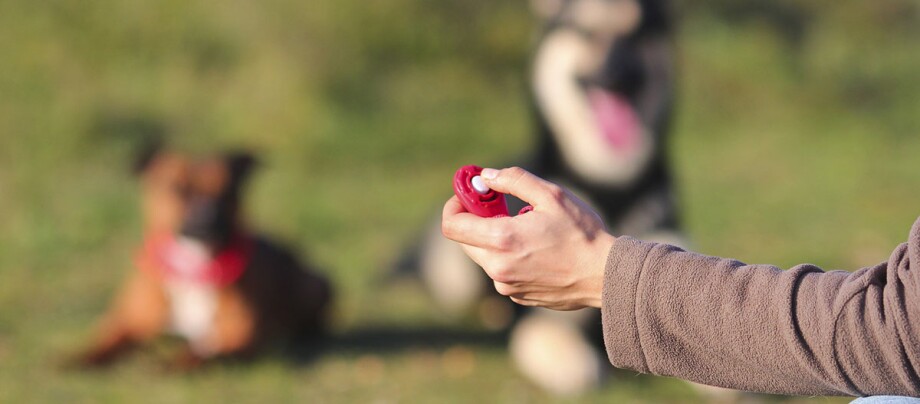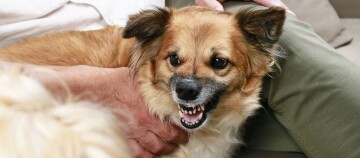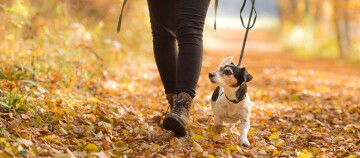Clicker Training for Dogs – Learn How Clicker Training Works
07.10.2022 - Reading time: 4 minutes

Clicking, what does that mean? Clicker training is a method that has been adopted from findings from behavioural research, to motivate dogs to perform the required behaviour through an acoustic signal (click) and the associated reward. You might be surprised to know that your dog reacts better to a click than to a spoken command. This shows that most dogs react favourably to clicker training and learn how to resolve tasks in a fun way. Read here how clicker training works and try it for yourself today!
Understanding and preparing clicker training
Clicker training is a good method to motivate your dog to behave in a desired way by using positive reinforcement. For this all you need is a suitable and healthy treat and a clicker. The clicker makes a neutral sound which isn’t heard in daily life and, as opposed to your voice, is free from emotion. The finger operating the clicker is, furthermore, much faster than a spoken command or praise. The short “click” tells your dog clearly that “you did that very well and you’ll get a treat for it now.”
Before this link is made, your dog must learn that following a click, a tasty treat will follow. This first step with clicker training is called “classic conditioning”. The sound of the click is, therefore, “secondary enforcement”, which advertises the “primary reinforcement” of the treat. Both together should lead to desired behaviours in your dog.
Start clicker training with your dog only when you’ve first “conditioned” yourself, since correct timing is very important with clickers. With a bit of practice you can learn to time your clicks exactly when a certain event has occurred.
Turn people into clickers: how to use them properly
In order to get the required precision when clicking, the following exercise is recommended for which you need a partner and a tennis or bouncy ball:
Stand opposite your partner and hold the clicker ready. Get your partner to drop the tennis ball on the floor. Click at the exact moment the ball hits the floor. Practise until you have perfected it. To vary this, your partner can throw the ball in the air and you click at the exact moment the ball reaches the top of its arc.
Dog and clicker meet: conditioning
At first, the clicker is completely meaningless to your dog. The first clicker training exercise is, therefore, about conditioning your dog to connect the click with a treat. To do this beginners should equip themselves initially with a bag of treats and a special clicker. For the first round of exercises, find a place free from distractions and begin to practise the conditioning with your dog.
The first click should occur casually without you expecting anything from your dog. You click and immediately give your dog a treat. Click – treat – click – treat. Repeat this procedure per training session approx. 10 to 20 times.
When doing so you should follow these rules:
- Put the treat in your hand only after clicking.
- Give your dog the treat immediately after clicking.
- Don’t aim the clicker at your dog.
- Don’t look at your dog in the eyes.
- Don’t speak to your dog.
To test whether your dog has been conditioned to it, use the clicker when they’re distracted by something else. If they react to the noise of the clicker and come to you expecting something and give you their full attention, then you can assume that they understand what the clicker means for them and you don’t need to train them further.
Now, don’t make the mistake and use the clicker for other reasons, for example, to call your dog or just to get their attention. The clicker should only be used to confirm that they will get a treat (or some other reward).
Clicker training has no practical disadvantages since the clicker is used for treats but not to replace them.
Many possibilities and a few novice mistakes
You can use clicker training for both practical exercises as you train your dog, for example when training puppies as well as for sporty agility exercises.
If clicker training doesn’t take off and your dog just doesn’t understand what you expect from them, then you shouldn’t doubt them or react as if you were annoyed! First consider whether some mistakes may have slipped into your clicker training.
The most common source of mistakes is:
- The tasks you give your dog are still too difficult for them.
- You are not precise enough with the clicker.
- Has your dog still not understood the initial conditioning?
- If you use your voice, you distract your dog from the clicker.
A popular clicker exercise: target training
With target training, your dog learns how to touch a target with their nose or your finger and then follow it. By doing this, soon you will be able to accompany them through an agility slalom or onto the scale at the vet.
This is how:
- Act as if you have a treat between your index finger and your thumb.
- If your dog gets curious and goes to or touches your finger or the target with their nose, then click and give them a treat.
- Your timing has to be perfect. As soon as their nose touches the target then click! No sooner and no later!
- Repeat this exercise until your dog is behaving as you want without any delay. Now give them the command “touch” and give them their treat as soon as their nose is touching.
- Gradually practise more and more. Let your dog follow your hand/target before giving them the treat. A few minutes of practice is enough at the beginning!
Tips: There are special target sticks which combine a telescope pole and a clicker.


